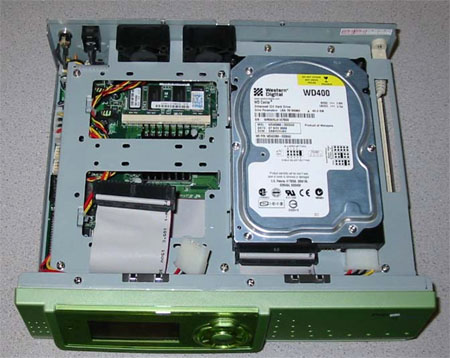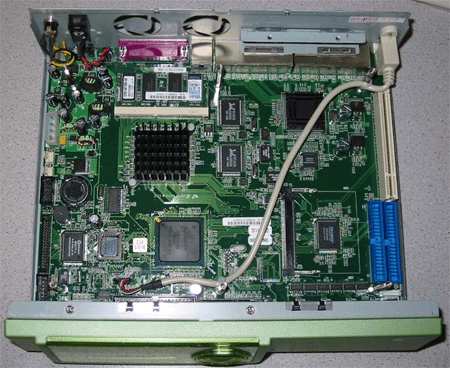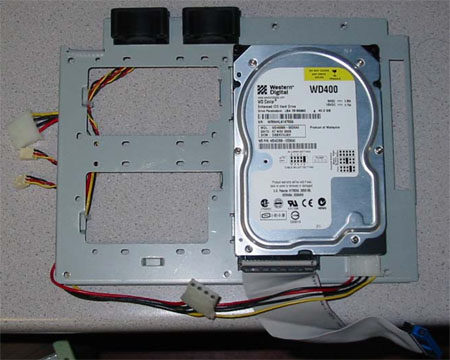ArmorLink Post Genie: Network Convergence in a Little Green box
by Brian Ng on July 13, 2004 12:05 AM EST- Posted in
- Networking
System Internals
Opening the Post Genie was quite simple. There are two screws on the back and four on the bottom. Pulling out the chassis reveals a tray for two hard drives sitting above the motherboard. The hard drive(s) is connected by PC standard power and IDE cables. Our evaluation version came with a 40 GB hard drive instead of the standard 200 GB. The 200 GB capacity should be more than enough for the Post Genie's targeted audience. From a performance standpoint, using SCSI drives would make the read and write speeds faster. However, we feel that the slight performance benefit would not justify the additional costs. Removing the tray exposes what looks like a modified laptop motherboard with standard components.Taking a detailed look at the motherboard reveals two IDE and one floppy controller, an empty PCI slot, a Phoenix BIOS, and Promise Technology PDC20265 IDE controller chips. The PDC20265 is an ATA100 controller that supports software RAID and is widely used by motherboard manufacturers such as Asus. Beneath the two heatsinks sits the AMD Geode GX1 CPU and the Micrel's KS8999 Ethernet integrated switch IC. The Geode is an x86 CPU that is designed for appliances with a low average power consumption of 1.2W. For its Ethernet ports, the Post Genie is powered by dual Realtek 810L chips. One of the chips is used for the WAN port, while the other is used for the LAN ports with the KS8999 switch IC between them.
Below is a picture of the motherboard with the two heatsinks removed.
The Post Genie uses a 128 MB SODIMM for its main memory with an additional slot for more RAM. While 128 MB of RAM might seem limited in today's systems with half a gigabyte or more, our benchmark tests showed that the Post Genie was more than able to keep up with the traffic even for a busy small business. Moreover, it is unclear if more RAM can be added or if there will be any performance increase by simply replacing the 128 SODIMM with a higher capacity one. Finally, two SanDisk SDTNFAH-128 16 MB chips are used for the Post Genie's embedded OS.
With some ingenuity, it should be possible to convert the Post Genie to a full fledge headless Linux box. However, the current $1000 price tag puts the Post Genie at a very expensive toy for would-be hackers. Perhaps as the price comes down on the Post Genie, there will be more interest in its other potential.














14 Comments
View All Comments
lewis71980 - Tuesday, July 13, 2004 - link
Toshiba Magnia SG20 did this 2 years ago. (apart from the webmail)Pete
johnsonx - Tuesday, July 13, 2004 - link
surely you meant 8 LAN and 1 WAN ports, not the other way around.compaqsupport - Wednesday, July 4, 2018 - link
Great review and an amazing concept. We all know the motherboard is the heart of laptop and manufacturing them remains a challenge. If you want to get more knowledge about it, then you can find it here: Compaq Support number compaqsupportnumber.comcompaqsupport - Wednesday, July 4, 2018 - link
http://www.compaqsupportnumber.com/